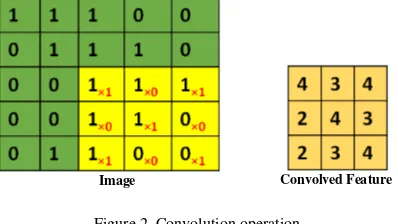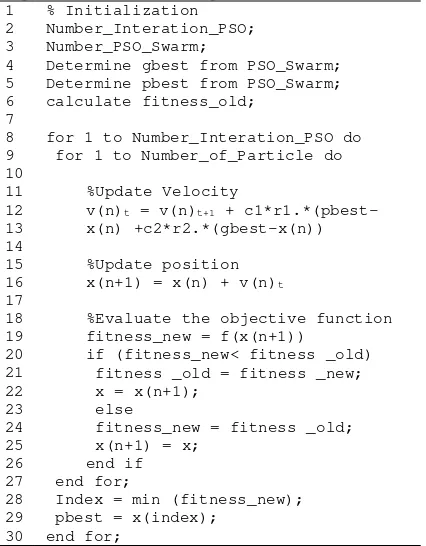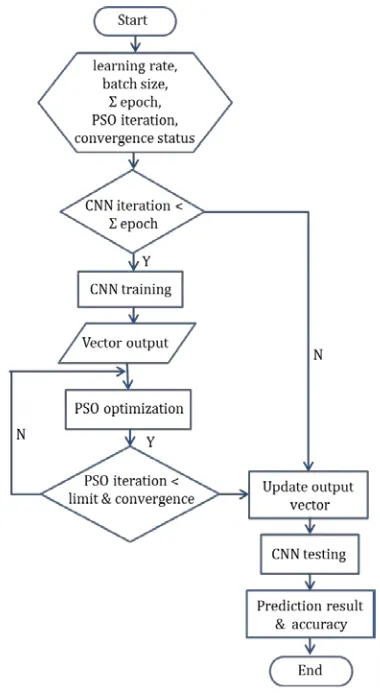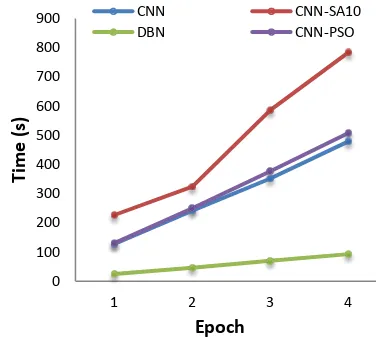DOI: http://dx.doi.org/10.21609/jiki.v9i1.366
PARTICLE SWARM OPTIMIZATION (PSO) FOR TRAINING OPTIMIZATION ON CONVOLUTIONAL NEURAL NETWORK (CNN)
Arie Rachmad Syulistyo1, Dwi M J Purnomo1, Muhammad Febrian Rachmadi2, and Adi Wibowo3
1 Faculty of Computer Science, Universitas Indonesia, Kampus Baru UI, Depok, 16424, Indonesia 2 School of Informatics, The University of Edinburgh, 11 Crichton Street, Edinburgh EH8 9LE, United
Kingdom
3 Department Micro-Nano System Engineering, Graduate School of Engineering, Nagoya University, 1
Furocho, Chickusa Ward, 464-8603 Japan
E-mail: arie.rachmad@ui.ac.id
Abstract
Neural network attracts plenty of researchers lately. Substantial number of renowned universities have developed neural network for various both academically and industrially applications. Neural network shows considerable performance on various purposes. Nevertheless, for complex applications, neural network’s accuracy significantly deteriorates. To tackle the aforementioned drawback, lot of research-es had been undertaken on the improvement of the standard neural network. One of the most pro-mising modifications on standard neural network for complex applications is deep learning method. In this paper, we proposed the utilization of Particle Swarm Optimization (PSO) in Convolutional Neural Networks (CNNs), which is one of the basic methods in deep learning. The use of PSO on the training process aims to optimize the results of the solution vectors on CNN in order to improve the recog-nition accuracy. The data used in this research is handwritten digit from MNIST. The experiments exhibited that the accuracy can be attained in 4 epoch is 95.08%. This result was better than the conventional CNN and DBN. The execution time was also almost similar to the conventional CNN. Therefore, the proposed method was a promising method.
Keywords: deep learning, convolutional neural network, particle swarm optimization, deep belief network
Abstrak
Jaringan syaraf tiruan menarik banyak peneliti dewasa ini. Banyak universitas-universitas terkenal telah mengembangkan jaringan syaraf tiruan untuk berbagai aplikasi baik kademik maupun industri. Jaringan syaraf tiruan menunjukkan kinerja yang patut dipertimbangkan untuk berbagai tujuan. Meskipun begitu, kinerja dari jaringan syaraf tiruan merosot dengan signifikan untuk masalah-masa-lah yang kompleks. Untuk menyelesaikan masamasalah-masa-lah tersebut di atas, banyak penelitian yang dilakukan untuk meningkatkan kinerja dari jaringan syaraf tiruan standar. Salah satu pengembangan yang men-janjikan untuk jaringan syaraf tiruan pada kasus yang kompleks adalah metode deep learning. Pada penelitian ini, diusulkan penggunaan metode Particle Swarm Optimization (PSO) pada Convolutional Neural Networks (CNNs), yang merupakan salah satu metode dasar pada deep learning. Penggunaan PSO dalam proses pelatihan bertujuan untuk mengoptimalkan hasil vektor solusi pada CNN, sehingga dapat meningkatkan akurasi hasil pengenalan. Data yang digunakan dalam penelitian ini adalah data angka yang berasal dari MNIST. Dari percobaan yang dilakukan akurasi yang dicapai dengan 4 iterasi adalah 95,08%. Hasil ini lebih baik dari CNN konvensional dan DBN. Waktu eksekusinya juga men-dekati CNN konvensional. Oleh karena itu, metode yang usulkan adalah metode yang menjanjikan.
Kata Kunci:deep learning, convolutional neural network, particle swarm optimization, deep belief network
1. Introduction
In recent years, many researchers conducted studi-es on machine learning with deep hierarchical arc-hitecture. The term deep hierarchical learning was introduced by Hinton et al. [1]. They proposed a method to transform high dimensional data into
low dimension data. They employed multilayer neural network with a small middle layer to re-construct the input vector. Today, machine learn-ing with deep hierarchical learnlearn-ing is named as deep learning.
lear-Figure 1. The original Convolutional Neural Networks (CNN) architecture [7]
12@10x10 S4: f. maps 12@5x5 C5: layer
120
Full connection
Full connection
Gaussian connection
F6: layer84
OUTPUT 10 ning regarded as a “new-generation of neural
net-works” [2]. Deep learning is research intersection between many areas, such as neural networks, ar-tificial intelligence, pattern recognition, signal processing, optimization, and graphical model. Feedforward neural networks or Multilayer Per-ceptron (MLPs) with many hidden layers, which is often called Deep Neural Networks (DNN), is a good example of a model with deep architecture. Deep learning demonstrated impressive results and has been applied in several fields, like object recognition, computer vision, voice search, con-versational speech recognition, and language pro-cessing.
From a wide variety descriptions that exist, deep learning generally has two aspects [2]. The first is deep learning is a model consisting of mul-tiple layers of nonlinear information process-ing. The second is deep learning is a supervised or an unsupervised learning method to represent the features of the bottom layer to the top layers.
Several variations of deep learning are conti-nually being researched and many of them have been applied into some machine learning tasks. In many cases, deep learning exhibited significant improvement on results, compared to previous conventional methods. There are plenty of deep learning algorithms which have been developed such as, Deep Neural Networks (DNNs) [1], Deep Boltzmann Machines (DBMs) [3], Recurrent Neu-ral Networks (RNNs) [4], and Deep Auto encod-ers [5].
From many deep learning methods, there are 3 basic models that underlie many of the deep lea-rning methods, i.e. Deep Belief Networks (DBNs) [6], Convolutional Neural Networks (CNNs) [7], and Stacked Auto Encoder (SAE) [8]. These three models are the most prominent and become build-ing blocks for many deep learnbuild-ing methods, such as Multiresolution DBN (MrDBN) [9], an exten-sion of the DBN or Scale-Invariant Convolutional Neural Network (SiCNN) [10] developed based
on the CNNs model.
In this research, we focus handwritten digit recognition problem based on data from MNIST. From three basic models, we empowered CNNs method as our basic algorithm. CNN was employ-ed due to its high accuracy on MNIST datasets [11].
CNNs is a type of feed forward neural net-work inspired by the structure of visual system. CNN consists of many neurons that have weights and biases, where each neuron receives several in-puts and perform dot products. In terms of arch-itecture, CNNs composed of one or more convo-lutional layers with subsampling stages and one or more fully connected layers as found in a standard multi-layer neural networks.
Even though standard CNN has shown con-siderable accuracy, there are still a lot of space for improvement. To ameliorate performance of CNN in recognition task, we used PSO to optimize out-put vector from CNNs. The utilization of PSO is due to its powerful performance on the optimiza-tion problems.
PSO in an optimization method developed by Eberhart and Kennedy [12]. This method is inspired by social behavior of animals that do not have a leader in their group. PSO consists of a sw-arm of particles, where the particles represent a potential solution.
To assess our proposed method, we compare results obtained from proposed method with other existing algorithms results. The existing algorit-hms used for comparison are the original CNNs and Deep Belief Networks (DBNs). The perform-ance criteria used in this research are error and accuracy.
1, February 2016
Image Convolved Feature
Figure 2. Convolution operation
Convolved Feature Pooled Feature
Figure 3. Illustration of pooling process
Figure 4. Restricted Boltzmann Machines (RBMs) 2. Methods
Convolution Neural Networks (CNNs)
Convolutional Neural Networks (CNNs) is inspi-red by cat’s visual cortex [12]. CNN generally consists of 3 layers which are convolutional layer, subsample/pooling layer, and fully connected la-yer. Convolution layer shares a lot of weights wh-ereas pooling layer performs subsampling func-tion to resulted output from convolufunc-tion layer and reduce data rate of the layer below. The outputs from pooling layer are used as an input to several fully connected layers. Figure 1 shows the archi-tecture of CNNs [7], and the convolution opera-tion is illustrated on Figure 2. Convolved feature that is generally called feature maps is the result of convolving the filter/kernel on dataset.
The convolution process can be written by the following equation(1):
∑ ∑ − −
= =
m n
n j m i K n m I j i K I j i
S(, ) ( * )(, ) ( , ) ( , ) (1)
where I is an input image, K is kernel/filter used in convolution process, m is row of image, and n is column of image. The subsample or pooling is the process to reduce feature map. The concept of pooling process almost equal to convolution pro-cess that is convolving filter on input data. How-ever, the differences pooling process on shifting filter that does not overlap on each filter compare with convolution process. The pooling illustration can be seen on Figure 2.
Deep Belief Networks (DBNs)
Deep Belief Networks (DBNs), which was intro-duced by Hinton, et al. [6], is a probabilistic gra-phical model consisting of multiple layers with hidden variables. DBNs are trained using greedy layer wise algorithm which can optimize the
wei-of Restricted Boltzmann Machines (RBMs), a special kind of Boltzmann Machines, that consist-ing a layer of visible unit and a layer of hidden units, with undirected and symmetrical connecti-ons between visible and hidden layer, but there is no connection among units in the same layer. Illu-stration of RBM models can be seen in Figure 4.
The lower layer v is the visible layer, and the top layer h is the hidden layer, where these two la-yers are stochastic binary variables. The weights between the visible layer and the hidden layer (W) are undirected. In addition each neuron has a bias.
The join distribution function p(v,h) of the visible units v and the hidden units are defined in equation(2) in the form of an energy function.
𝑝𝑝(𝑣𝑣,ℎ) =exp (−𝐸𝐸(𝑣𝑣,ℎ))
𝑍𝑍 (2)
where Z is the partition function and given by su-mming all possible pairs of visible and hidden units as shown by equation(3).
𝑍𝑍=∑𝑣𝑣,ℎexp (−𝐸𝐸(𝑣𝑣,ℎ)) (3)
Figure 5. CNN Architecture in the Proposed Method ween visible and hidden units. The update rule for RBM weights are:
∆𝑊𝑊𝑖𝑖𝑗𝑗=𝐸𝐸𝑑𝑑�𝑣𝑣𝑖𝑖ℎ𝑗𝑗� − 𝐸𝐸𝑚𝑚(𝑣𝑣𝑖𝑖ℎ𝑗𝑗) (5)
where Ed(vihj) is the expectation in the training da-ta and Em(vihj) is the same expectation that defin-ed by the model. RBMs are traindefin-ed using Contras-tive Divergence (CD) algorithm to approximate the expected value.
Particle Swarm Optimization (PSO)
Particle swarm optimization (PSO) algorithm is one of evolutionary algorithm which was firstly proposed in 1995 [13]. PSO has widely been em-ployed in miscellaneous field, to cite an instance swarm robot for odour source localization purpose [14, 15].
PSO algorithm consist several consecutive steps. First of all, initialization which randomly select the particles as searching agents (x) as well as the velocities (v). Secondly the particles then inserted into cost function to find local bests (pbest)
and global best (gbest). Local best is defined as the
location on which the cost is the smallest for each particle. Meanwhile, global best is the location on which the cost is smallest among the local bests. Thirdly, the particles are updated by empowering equation(6) and equation(7).
𝑣𝑣𝑛𝑛+1=𝑣𝑣𝑛𝑛+𝑐𝑐1𝑟𝑟1(𝑝𝑝𝑏𝑏𝑏𝑏𝑏𝑏𝑏𝑏− 𝑥𝑥𝑛𝑛) +
𝑐𝑐2𝑟𝑟2(𝑔𝑔𝑏𝑏𝑏𝑏𝑏𝑏𝑏𝑏− 𝑥𝑥𝑛𝑛) (6)
𝑥𝑥𝑛𝑛+1=𝑥𝑥𝑛𝑛+𝑣𝑣𝑛𝑛+1 (7)
Where c1 and c2 are the constants, r1 and r2 are random numbers, and n is iteration. The algorithm of PSO can be written as follows:
Algorithm 1: Particle Swarm Optimization
1
Determine gbest from PSO_Swarm; Determine pbest from PSO_Swarm; calculate fitness_old;
for 1 to Number_Interation_PSO do for 1 to Number_of_Particle do
%Update Velocity
v(n)t = v(n)t+1 +
c1*r1.*(pbest-x(n) +c2*r2.*(gbest-c1*r1.*(pbest-x(n))
%Update position x(n+1) = x(n) + v(n)t
%Evaluate the objective function fitness_new = f(x(n+1))
if (fitness_new< fitness _old) fitness _old = fitness _new; x = x(n+1);
else
fitness_new = fitness _old; x(n+1) = x;
end if end for;
Index = min (fitness_new); pbest = x(index);
end for;
Proposed Method
Figure 5 shows the CNNs architecture used in the proposed method, where it is consist of an input image that will be processed using 6 convolution kernel with size 5x5 pixels, 6 sub-sampling kernel with size 2x2 pixels, 12 convolution kernel with size 5x5 pixels, 12 subsampling kernel with size 2x2 pixels and the last layer is the vector output of CNN. The proposed method process can be seen on Figure 6. In Figure 6 Y denotes the condition is met, whereas N represent the condition is not met. PSO in this study would optimize the output vector. The output vector would be augmented by
δx to acquire better value. The value of δx itself is
1, February 2016
Figure 6. Flowchart of the proposed method
calculate the fitness function, the root mean squ-are error between output vectors after augmented
with δx and the true output would be employed. Generally, the process of the proposed meth-od consists of several steps as shown below: 1) the first step is initializing the learning rate of the CNNs with the value is 1 based on the experi-ment. Batch size of CNNs is 50, the number of CNNs epoch in the range of 1 to 4, PSO iteration is 10. The convergence status of PSO is used to check the convergences of PSO, if the error value has not changed for three iterations, then the PSO is considered as convergent; 2) after setting up the experiment, the next step is run CNNs training process, where the detail of the process can be se-en in section 2.1.
The result of CNNs is vector output that will be optimizing using PSO algorithm. PSO optimi-zation in this study serves to make the value of loss function on CNN becomes minimal; 3) the output vector will be update if the solution of swa-rm has less error compare with old vector output; 4) the PSO will run as long as the iteration num-ber of PSO and the convergence solution have not fulfilled; 5) after the CNN Training, the model wi-ll be tested with testing data that consist of 10000 data; 6) the result of CNN test is accuracy of CNN, it represent how precise of the CNN model can predict the actual value of testing dataset.
3. Results and Analysis
Dataset
In this study we use the handwritten digits data ta-ken from MNIST database. This dataset has 28 x 28 pixel dimension and consist of 70000 data, in which 60000 data used for training and the rest data used for testing.
Experiment Result
In this chapter we will show the experiment result on deep learning method, such as Convolutional Neural Network, Deep Belief Network, and Con-volutional Neural Network Optimize with Simu-lated Annealing (SA) [16] and also compare the performance with proposed method. The experi-ment use handwritten Digit dataset from MNIST. And the running time of all the deep learning me-thod will compare each other to know how long the deep learning method can predict the test data-set.
Experiment on Handwritten Dataset
tively. The results of experiments showed the pro-posed method has a better accuracy than another deep learning method. Although the difference ac-curacy value is not high but it important be-cause the CNN does not need a lot of training epoch to get good accuracy. CNNPSO has better accuracy than CNNSA, it could be the advantages of PSO fast searching ability with minimum iteration of CNN. The error also exhibit the similar behavior. These due to the fact that PSO is a powerful algo-rithm for optimizing. Thus if com-pared to simu-lated annealing in particular, it has better perfor-mance.
As shown in Table 1, with only 4 epochs the accuracy of CNNPSO has reached 95.08%. This value was only slightly different from simulated annealing optimized CNN (95.19%). Meanwhile, CNN and DBN occupy the two last place with 94.81% and 91.14% respectively.
Figure 7. Error comparison of several algorithm
Figure 8. Time Comparison Based On Epoch Value
0
ACCURACY PERFORMANCE ON ALL DEEP LEARNING METHOD
Method Number of Epoch
1 2 3 4
CNN 88.87 92.25 93.9 94.81
DBN 87.46 89.72 90.64 91.14 CNN-SA10 89.18 92.38 94.2 95.19
CNN-PSO 89.52 92.31 93.91 95.08
rithm as well as the particles calculation. Never-theless, if compared to CNNSA10, CNNPSO was still faster.
4. Conclusion
Based on the experiment result that have been conducted it can be conclude that the proposed method CNNPSO has good accuracy. The consi-derable accuracy (95.08%) was attained with only 4 epoch. Moreover the proposed method exhibited better performance than CNN, DBN. Even though its accuracy is lower than CNNSA, to obtain the accuracy nearby, CNNPSO consumed shorter ti-me. If compared to the conventional CNN, CNN-PSO consumed only slightly longer time. Howev-er, it has to be improved. The improvement can be focused on how to give restricted range on delta x so the proposed method get optimal vector output faster.
Acknowledgement
This work was supported by Directorate Research of Universitas Indonesia funding in 2015. The title of the research is Laboratory Infra-structure. This grant number is 1831/UN2.R12/ HKP.05.00/2015.
References
[1] G. E. Hinton and Ruslan R. Salakhutdinov, "Reducing the dimensionality of data with
neural networks." Science Journals 313.5786 (2006): 504-507.
[2] L. Deng and D. Yu, “Deep Learning: Me-thods and Applications”, Foundations and Trends® in Signal Processing, Vol. 7, Nos.
3–4 (2013) 197-387.
[3] R.R. Salakhutdinov and G. E. Hinton, “Deep Boltzmann Machines”, In Proceeding of In-ternational Conference of Artificial Intelli-gence and Statistics, vol. 12, 2009.
[4] J. Martens and I. Sutskever, “Learning Recu-rrent Neural Networks with Hessian-free Op-timization.” In Proceedings of International Conference on Machine Learning (ICML), 2011.
[5] H. Larochelle, Y. Bengio, J. Louradour, and P. Lamblin, “Exploring Strategies for Trai-ning Deep Neural Networks.” J. Machine Learning Research, vol. 10, pp. 1-40, 2009. [6] G.E. Hinton, S. Osindero, and Y.W. Teh, “A
Fast Learning Algorithm for Deep Belief Ne-ts”, Neural Computation, vol. 18, no. 7, pp. 1527-1554, 2006.
[7] Y. LeCun, L. Bottou, Y. Bengio, and P. Haff-ner. “Gradient-based Learning Applied to Document Recognition”. In Proceedings of the IEEE, 86:2278–2324, 1998.
[8] Y. Bengio, P. Lamblin, D. Popovici, and H. Larochelle, “Greedy layer-wise training of deep networks,” in Advances in Neural In-formation Processing Systems 19 (NIPS’06), (B. Scholkopf, J. Platt, and T. Hoffman, eds.), pp. 153–160, MIT Press, 2007.
1, February 2016
[10] Y. Xu, T. Xiao, and J. Zhang, Scale-Invariant Convolutional Neural Networks, in arXiv: 1411.6369v1 [cs.CV], 2014.
[11] Ciresan, Dan; Meier, Ueli; Schmidhuber, Jürgen, Multi-column deep neural networks for image classification, IEEE Conference on Computer Vision and Pattern Recogniti-on, 2012.
[12] Hubel, D. and Wiesel, T. (1968). Receptive fields and functional architecture of monkey striate cortex. Journal of Physiology (Lon-don), 195, 215–243.
[13] J. Kennedy and R. Eberhart, “Particle swarm optimization”, In Proceedings of the IEEE International Conference Neural Network (ICNN), Nov. 1995, vol. 4 pp. 1942-1948. [14] W. Jatmiko, K. Sekiyama, and T. Fukuda, A
mobile robots pso-based for odor source lo-calization in dynamic advection-diffusion
environment, in Intelligent Robots and Sys-tems, 2006 IEEE/RSJ International Confe-rence on. IEEE, 2006, pp. 4527–4532. [15] W. Jatmiko, A. Nugraha, R. Effendi, W.
Pam-buko, R. Mardian, K. Sekiyama, and T. Fuku-da, Localizing multiple odor sources in a dy-namic environment based on modified niche particle swarm optimization with flow of wi-nd, WSEAS Transactions on Systems, vol. 8, no. 11, pp. 1187–1196, 2009.
[16]L. M. R. Rere, M. I. Fanany, A. M. Arymur-thy, Simulated Annealing Algorithm for De-ep Learning, Procedia Computer Science, no. 72, pp. 137–144, 2015.
![Figure 1. The original Convolutional Neural Networks (CNN) architecture [7]](https://thumb-ap.123doks.com/thumbv2/123dok/2807478.1687685/2.595.105.494.584.724/figure-original-convolutional-neural-networks-cnn-architecture.webp)



